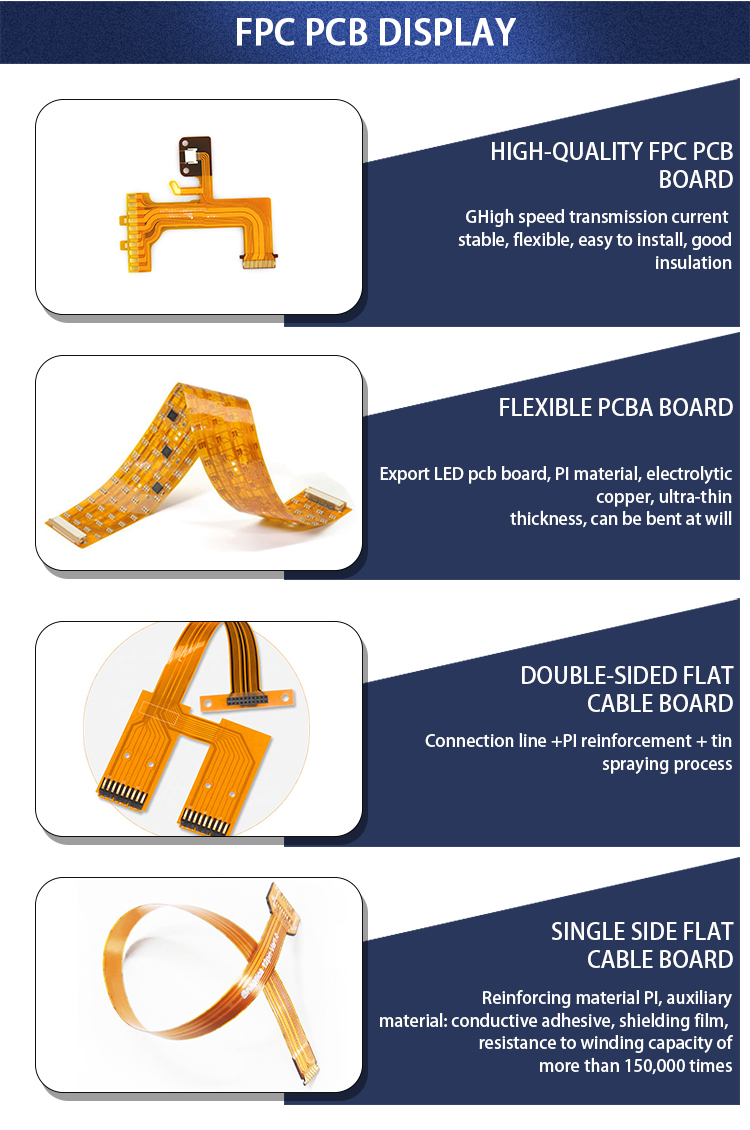Product Details
Introduction:
Double-sided flexible PCBs have revolutionized the electronics industry with their unique design and applications. In this article, we will delve into the world of double-sided flexible PCBs, discussing their uses, manufacturing process, material options, reliability, limitations, soldering methods, pricing, and design considerations.

High quality FPC pcb board: with high speed transmission current stable,flexible,easy to install,good insulation.
Flexible pcba board:export led pcb board,PI material,Electrolytic copper,ultra-thin thickness,can be bent at will.
Double side flat cable flex pcb manufacturer:connection line+PI reinforcement+tin spraying process.
SINGLE SIDE FLAT CABLE BOARD:Reinforcing material Pl, auxiliary
material: conductive adhesive, shielding film,resistance to winding capacity of more than 150,000 times.
Applications of Double-Sided Flexible PCBs: Double-sided flexible PCBs find applications in a wide range of industries. They are commonly used in smartphones, tablets, wearable devices, and other portable electronics. Additionally, they are utilized in automotive systems, including infotainment systems, GPS modules, and engine control units. Medical devices such as pacemakers and hearing aids also benefit from the flexibility and compactness of double-sided flexible PCBs.
Differences from Single-Sided Flexible PCBs: Compared to single-sided flexible PCBs, double-sided boards offer increased circuit density and functionality. With electrical connections on both sides, designers can optimize space utilization and incorporate more components. This allows for more complex and advanced electronic systems.
Manufacturing Process: The manufacturing process of double-sided flexible PCBs involves several steps. It begins with the design and layout of the circuit, followed by the fabrication of the flexible substrate. The circuit pattern is then etched onto the substrate using specialized techniques. Finally, the components are mounted and soldered onto both sides of the board.
Material Options: Double-sided flexible PCBs can be made from various materials, including polyimide, polyester, and PTFE (polytetrafluoroethylene). Each material offers different properties such as flexibility, thermal resistance, and chemical resistance. The choice of material depends on the specific requirements of the application.
Reliability: Double-sided flexible PCBs undergo rigorous testing to ensure their reliability. Factors such as temperature cycling, vibration resistance, and moisture resistance are evaluated to guarantee their performance under various conditions. Manufacturers also employ quality control measures to maintain consistent production standards.
Limitations in Size and Thickness: Double-sided flexible PCBs have certain limitations in terms of size and thickness. The size is typically limited by the manufacturing process and the available equipment. Similarly, the thickness is determined by the flexibility requirements and the number of layers. Designers must consider these limitations while creating their circuits.
Soldering Methods: Double-sided flexible PCBs can be soldered using various methods, including reflow soldering, wave soldering, and hand soldering. The choice of soldering method depends on factors such as component type, board complexity, and production volume. Each method has its advantages and considerations.
Pricing: The pricing of double-sided flexible PCBs varies depending on factors such as size, complexity, material choice, and production volume. Generally, they are more expensive than single-sided flexible PCBs due to the additional manufacturing steps and increased functionality.
Design Considerations: Designing double-sided flexible PCBs requires careful consideration of factors such as component placement, routing, and signal integrity. Designers must ensure proper heat dissipation, minimize signal interference, and optimize space utilization. Collaboration between designers and manufacturers is crucial to achieve the desired functionality and reliability.
Conclusion: Double-sided flexible PCBs offer a versatile solution for various electronic applications. Their ability to provide electrical connections on both sides, combined with their flexibility, makes them an ideal choice for compact and complex electronic systems. By understanding their applications, manufacturing process, material options, limitations, and design considerations, engineers can harness the full potential of double-sided flexible PCBs in their projects.
Here are our Product Capabilities of the Flexible PCBs, welcome to send your quote to us :
| Item | Flexible PCB |
| Max Layer | 8L |
| Inner Layer Min Trace/Space | 3/3mil |
| Out Layer Min Trace/Space | 3.5/4mil |
| Inner Layer Max Copper | 2oz |
| Out Layer Max Copper | 2oz |
| Min Mechanical Drilling | 0.1mm |
| Min Laser Drilling | 0.1mm |
| Aspect Ratio(Mechanical Drilling) | 10:1 |
| Aspect Ratio(Laser Drilling) | / |
| Press Fit Hole Ttolerance | ±0.05mm |
| PTH Tolerance | ±0.075mm |
| NPTH Tolerance | ±0.05mm |
| Countersink Tolerance | ±0.15mm |
| Board Thickness | 0.1-0.5mm |
| Board Thickness Tolerance(<1.0mm) | ±0.05mm |
| Board Thickness Tolerance(≥1.0mm) | / |
| Impedance Tolerance | Single-Ended:±5Ω(≤50Ω),±10%(>50Ω) |
| Differential:±5Ω(≤50Ω),±10%(>50Ω) | |
| Min Board Size | 5*10mm |
| Max Board Size | 9*14inch |
| Contour Tolerance | ±0.05mm |
| Min BGA | 7mil |
| Min SMT | 7*10mil |
| Surface Treatment | ENIG,Gold Finger,Immersion Silver,Immersion Tin,HASL(LF),OSP,ENEPIG,Flash Gold;Hard gold plating |
| Solder Mask | Green Solder Mask/Black PI/Yellow PI |
| Min Solder Mask Clearance | 3mil |
| Min Solder Mask Dam | 8mil |
| Legend | White,Black,Red,Yellow |
| Min Legend Width/Height | 4/23mil |
| Strain Fillet Width | 1.5+0.5mil |
| Bow & Twist | / |
Address of Plant
PCB Factory:
A1 Building, B Zone, Ditang Industrial Zone, Ditang Road, Shajing Street, Bao'an District, Shenzhen, China
PCBA Factory:
Room 805, Room 806, Room 809, No. 96, Chuangqiang Road, Ningxi Street, Zengcheng District, Guangzhou City, Guangdong Province, P.R. China
Office Address:
Room 805, Room 806, Room 809, No. 96, Chuangqiang Road, Ningxi Street, Zengcheng District, Guangzhou City, Guangdong Province, P.R. China